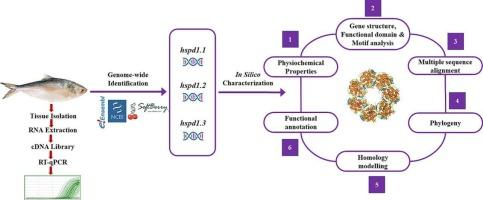Genome-wide characterization and seasonal modulation of Hsp60 expression in juvenile Hilsa Shad across distinct upstream habitats
IF 2.8
Q3 Biochemistry, Genetics and Molecular Biology
Journal of Genetic Engineering and Biotechnology
Pub Date : 2025-10-07
DOI:10.1016/j.jgeb.2025.100586
引用次数: 0
Abstract
Heat shock protein 60 acts as a molecular chaperone that assists in proper protein folding under stress conditions. However, its genomic features and temperature-responsive behavior have not yet been studied in Hilsa Shad. In this study, we employed both computational and experimental approaches to investigate the genomic, proteomic, and expression dynamics of Hsp60 in this ecologically and economically important anadromous species. We identified three distinct gene copies which showed high sequence similarity compared to the Hsp60 gene of the well-studied three-spined stickleback. The physico-chemical properties, gene structure, functional domains and motifs, and sequence alignment were analyzed to characterize the paralogs. The phylogenetic analysis and structural modeling further confirmed their close evolutionary relationship and high structural similarity. However, Hilsa juvenile experience winter in the Meghna river in February and autumn in the Surma river in September due to their upstream migration. Notably, all three Hsp60 gene paralogs were significantly upregulated in the gill and liver during the warmer autumn season. While the level of relative expression was moderate in muscle and modest in kidney. This finding suggests a strong role for these genes in the thermal stress response of Hilsa Shad in the Surma river. In addition to, it demonstrates the role of Hsp60 in maintaining homeostasis in juvenile Hilsa Shad under fluctuating environmental conditions. It also aligns with the established role of heat shock proteins in thermal biology, where Hsp60 facilitates cellular protection and adaptation of juvenile Hilsa Shad to changing thermal regimes.

不同上游生境鲥鱼幼鱼Hsp60表达的全基因组特征和季节性调节
热休克蛋白60作为一种分子伴侣,在应激条件下帮助适当的蛋白质折叠。然而,其基因组特征和温度响应行为尚未在Hilsa Shad中研究。在这项研究中,我们采用计算和实验两种方法研究了Hsp60在这种生态和经济上重要的溯河产卵物种中的基因组学、蛋白质组学和表达动态。我们鉴定出三个不同的基因拷贝,与研究充分的三棘棘鱼的Hsp60基因序列相似。分析了其理化性质、基因结构、功能域和基序、序列比对等特征。系统发育分析和结构建模进一步证实了它们密切的进化关系和高度的结构相似性。然而,希尔萨幼崽由于上游迁徙,2月在梅克纳河过冬,9月在苏尔马河过冬。值得注意的是,在温暖的秋季,所有三种Hsp60基因在鳃和肝脏中都显着上调。而在肌肉和肾脏中相对表达水平中等。这一发现表明,这些基因在苏尔玛河Hilsa Shad的热应激反应中起着重要作用。此外,它还证明了Hsp60在波动环境条件下维持鲥鱼幼鱼体内平衡的作用。这也与热休克蛋白在热生物学中的既定作用一致,其中Hsp60促进了Hilsa Shad幼鱼对不断变化的热环境的细胞保护和适应。
本文章由计算机程序翻译,如有差异,请以英文原文为准。
求助全文
约1分钟内获得全文
求助全文
来源期刊

Journal of Genetic Engineering and Biotechnology
Biochemistry, Genetics and Molecular Biology-Biotechnology
CiteScore
5.70
自引率
5.70%
发文量
159
审稿时长
16 weeks
期刊介绍:
Journal of genetic engineering and biotechnology is devoted to rapid publication of full-length research papers that leads to significant contribution in advancing knowledge in genetic engineering and biotechnology and provide novel perspectives in this research area. JGEB includes all major themes related to genetic engineering and recombinant DNA. The area of interest of JGEB includes but not restricted to: •Plant genetics •Animal genetics •Bacterial enzymes •Agricultural Biotechnology, •Biochemistry, •Biophysics, •Bioinformatics, •Environmental Biotechnology, •Industrial Biotechnology, •Microbial biotechnology, •Medical Biotechnology, •Bioenergy, Biosafety, •Biosecurity, •Bioethics, •GMOS, •Genomic, •Proteomic JGEB accepts
 求助内容:
求助内容: 应助结果提醒方式:
应助结果提醒方式:


